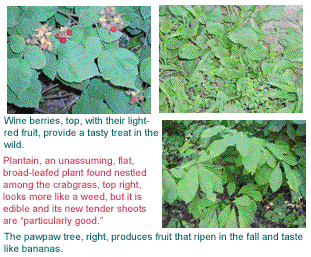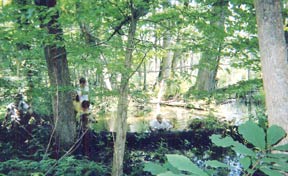
|
 Nature’s Survival Challenge Nature’s Survival Challenge
What would you do if you found yourself alone in the woods at night? Wish you’d learned your lessons in Calvert’s Wilderness Survival Camp.
by Vivian I. Zumstein
As 25 children dash between trees, the air fills with the sound of dry leaves crackling under scurrying feet. “Find a good tree!” commands one boy. “We need a good site for our shelter.”
Children throw possessive arms about the trunks of suitable trees to claim them. The melee of activity expands and intensifies as other kids compete to find building materials. They have only 30 minutes to erect a survival shelter large enough for at least one child.
Girls and boys rush to collect fallen branches to frame their shelters. “Over here! Help me with this branch.” The woods ring with calling voices. Sometimes it takes two children straining together to haul heavy limbs to lean against a support tree.
Cracks resound through the forest as the children break sticks to fit the growing frames. One boy, not content to collect branches from the ground, kicks the thin trunk of a dead, dry sapling. It snaps in two after a few well-delivered blows. Triumphant, he delivers his prize to the admiring members of his group.
Once the children complete the basic structure, they fill in spaces with smaller branches. Competition lessens. Small sticks litter the forest floor The frame complete, children harvest armloads of bright green ferns from a nearby hollow to spread over the sticks. Finally, they fling handfuls of dead leaves both inside of and on top of their shelter to insulate it from the ground below and to proof it against rain from above.
Maintaining body heat and staying dry are among the top priorities for wilderness survival. These Junior Rangers from Battle Creek Cypress Swamp Sanctuary will be judged not only on how fast they build but also on whether their shelter would protect them from the elements. Their Survival Challenge culminates a one-week wilderness camp at Kings Landing Park.
Would your children know these skills if they got lost during a family hike? Would they know to build a shelter? Alone in the dark, would they panic and wander even farther from the trail?
Do your children know the skills and understand the priorities of wilderness survival? Do you?
Our Lost Generation
Probably not, according to Jackie Waymire, Calvert County park ranger and site manager for Kings Landing Park in Huntingtown. Children today are out of touch with nature, she says. They come to camp with sparse information about the outdoors and vast misconceptions. If their parents have more wilderness savvy, few have passed that knowledge on to their children.
Shannan Todd, a naturalist at Flag Ponds Nature Park in Lusby and the leader of the Call of the Wild session of the camp, echoes Waymire’s concerns. “Nobody seems to go outside anymore,” Todd said.
Waymire, who led this summer’s Junior Ranger Corps and Daughters of the Woods survival camp sessions, grew up on a Calvert County farm and lives an outdoors life. Her survival campers are far more familiar with the mall than with the woods. Basic facts of nature are foreign to children growing up in housing developments — even ones with woods for back yards.
“Lots of kids don’t even know the way the sun goes,” Waymire laments. “While teaching orienteering, I have to repeat again and again that the sun moves from east to west during the day. Without knowing that basic, how can they figure out what direction they’re going?”

Other misconceptions abound. Spoiled by living with well-stocked refrigerators and with Giants and McDonalds only a short drive away, kids today can’t imagine missing even a snack, let alone a meal. Naturally, such kids think food is the most important item for survival. It’s not. It might even set back your quest for survival.
Waymire laughs as she recounts other misconceptions on the long list of failed nature quizzes.
Water is a survival requirement that kids take for granted — at least they did until Isabel passed through. Many milk-, juice- and soda-guzzling youngsters don’t even consider water a beverage. Water rinses their mouths after they brush their teeth; it fills swimming pools or flushes toilets; it is not a drink.
Only a few campers understand the importance of water. Even the kids who know they need water to survive underestimate how difficult it can be to obtain it in Chesapeake Country, where water seems so abundant.
“Kids think they can drink any kind of water, even from the river or Bay,” says Waymire.
But water from Chesapeake Bay is salty and from the Patuxent River brackish. Drinking water from either will accelerate rather than relieve dehydration. Parasites and bacteria present yet another set of problems.
Water runs fresh in creeks, but even it must be boiled 10 minutes before drinking. Rainwater, too, should be boiled before drinking. Boiling, however, requires fire and a container to hold the water …
How do you get past that?
Stones heated in a fire can be added to water placed in a natural cavity, such as the hollow of a log. If you can’t build a fire or find a watertight log, you can cut a grapevine and drink the sap. But you’d better to able to tell wild grapes from poison ivy.
Sounding tough? Graduates of this camp are real-life survivors.
“We want self-sufficient kids,” says Waymire. “We don’t want them to panic. We want them to know how to access the environment and make use of their situation.”
This Is Hard!
Campers are always surprised how difficult survival can be. Working as a team makes it easier, but some campers, especially the more independent ones, need regular reminders to cooperate. “In reality, it is hard to survive alone,” says Todd. It’s not like that TV game show Survivor where you get to vote people off.”
Survival experts agree that mental attitude can make all the difference. Some people faced with relatively minor challenges perish. Others survive extreme conditions against all odds. Why? People with a positive outlook and the motivation to survive frequently do. In fact, the first step in any survival situation is to stop, recognize the circumstances for what they are and think about what you can do with what you have at hand. It is not a time to lament what you need but don’t have.
Waymire and Todd teach that lesson. “We want the kids to use the land to help them to make a shelter or find food and water,” explains Todd. Thinking about what is available empowers the kids.
Enter the simple but versatile bandanna. “The bandanna is your friend,” advises Todd. A bandanna can cover your head against the sun or be worn as a headband to keep sweat out of your eyes. It can be a bandage, sling or tourniquet. It can carry foraged food. You can use it to filter water. Wet, a bandanna cools a feverish forehead or becomes a washrag. The list is as long as your imagination and the needs of a situation. Children who can think up 101 uses for a bandanna can devise many novel uses to make items they have at hand allies in survival.
But it isn’t always easy. Todd says that many of her campers struggle to maintain a positive outlook, especially at the beginning of new activities. The kids often rebel, complaining “This is hard!”
Like girls in the Junior Ranger Corps and Daughters of the Woods survival camp, counselors Alice Wright and Rowan Harris found the dirty work of camouflage satisfying.
 |
Down to Basics
Campers howl with distress to learn that, when push comes to shove, the average human can survive without food for a month or longer. But we cannot survive longer than a few days without water. In some survival situations, it’s best not to eat, even when food is available. If your water supply is limited, skip eating, for food increases your body’s need for water. Foraging for food is such hard work that it may use up more calories than the scrounged food replaces.
Waymire also cautions her would-be survivalists to eat new plants in small quantities. “Don’t just go shoveling it in,” she says. “Watch for signs of negative reactions. Some plants may not agree with your body.”
Even non-poisonous plants can cause allergic reactions in some people. The bottom line? It is better to go hungry than to get sick in addition to being lost.
The top survival items are shelter, including clothing, protection from the elements and fire; a way to signal for help; and water. Their ranking varies with the situation. If you have a reasonable expectation of a rapid rescue, a signaling device would be at the top of your list. Shelter would be the top priority if you were trying to survive in snow-covered mountains with nightfall closing in. Water is tops when you’re lost in the desert — or in any situation where you need to replenish body fluids lost through sweating.
Nature’s Table
Ignorance about what’s good to eat on nature’s table — and what’s not — also makes hunger dangerous for today’s unwary Hansels and Gretels. “Kids also think they can eat any berry out there,” says Waymire. “Some of those berries will kill them.”
On the other hand, there’s plenty that’s good to eat, though kids and adults alike may not recognize it as food. Naturalist Todd walked her campers around Flag Ponds Nature Park to point out edible plants.
One is plantain, an unassuming, flat, broad-leafed plant nestled among the crabgrass. “The new tender shoots of plantains are particularly good,” says Todd. Kids view the plant with suspicion. It looks too much like a weed to be appetizing. A stomach pinched and noisy with hunger would find a plantain far more appealing.
Farther down the road wine berries grow. They’re such favorites that Todd had to limit the number of berries her campers ate to three berries per child per forage. By September, only a few light-red berries still ripened in the filtered sunlight.
Other sources of wilderness nutrition in Chesapeake Country include new dandelion leaves and greenbrier in the spring. In fall, pawpaw fruit are delicious (rather like bananas) and acorns edible — if boiled until softened. Good to eat, too, is much of the cattail plant, including the roots and the brown top, before it has matured into fluff. Todd says it has a pleasant nutty flavor.
Campers love learning about edible plants, but they have a tougher time considering the animal possibilities. “You can’t eat a bunny!” a camper protested at Todd’s list of small animals that could be trapped for a meal.
Filling Your Shopping Cart
Plants offer far more than food to the savvy survivalist. The large, papaya-shaped leaves of the pawpaw can be crushed and rubbed on the skin as a mild insect repellent.
At the entrance to the park, Todd points to a paulownia tree. In the spring it displays huge spikes of light purple flowers. In fall, the tree is still covered with large, green foliage swaying in a light breeze. The leaves are huge: much broader than a man’s hand. The paulownia tree isn’t edible, but it is definitely useful. Todd urges kids to brainstorm uses of the tree’s large, soft leaves. “Yuk!” the kids balk in unison when she tells them the leaves substitute as toilet paper.
To a girl and boy, campers are grossed out by the thought of nature calls in the woods. Every year, Todd hears elaborate, unrealistic plans for avoiding the inevitable. She is older and wiser. Unfazed, she explains the advantages of leaves. Avoiding poison ivy is critical, but even non-poisonous leaves, such as oak, can be too too small and rough. Paulownia leaves are the wilderness equivalent of Charmin.
Blending In
Creatures that live in the wilderness are masters of camouflage. So are kids, in their own way, though their interest is blending in with other kids. Figuring out how best to hide in this new environment compels children to pay attention to the world around them.
The bright colors of their red or white T-shirts stand out against the woodland background. “I tell them you blend your shape into the surrounding area,” says Todd. Girls and boys learn how to use mud, twigs and leaves to cover their bodies. Once disguised, they lie low against rotting, creepy logs and under scratchy bushes to make themselves disappear.
Todd finds it funny that boys are far more reluctant than girls to cover their faces and bodies with mud. One girl decorated herself with abandon: mud all over, twigs and leaves woven into her hair.
“The only thing boys do is watch TV and drool,” said a camper in a group where boys were trying to dominate.
A majority of Calvert’s wilderness campers are boys, but roughly a third of the kids attending this summer’s coed camps were girls. There’s also a Daughters of the Woods session for girls only. “Some of those girls are every bit as tough as the boys,” says Waymire.
But, she cautions, “If you don’t want to get sweaty, dirty or be too hot or too cold, this is not the camp for you.”
The experience of feeling helpless and then discovering they are not is empowering for the children in the Junior Ranger Corps and Daughters of the Woods survival camp.
 |
Stretching the Senses
“Children have a very heavy dependence on their sense of sight,” says Todd. Not using all their senses to the fullest makes them miss much of the world around them. To break the sight-dependence, Todd plays a game that robs them of their primary sense, forcing them to fall back on other senses, especially hearing and touch. Children are led into the woods and blindfolded. To return to the campsite, they must follow the beat of a drum.
At first, campers protest and even cry. “I can’t see a thing!” several wail, though all understand that that is the point. Gradually, however, they listen to the drum and shuffle their feet to feel obstacles in their path. Confidence grows with every successful step. By the end, they beg to do it again.
Waymire uses a different method for the same lesson. On the overnight stay, she leads the kids into the woods and orders them to turn off their flashlights. For children accustomed to streetlights, instantaneous incandescent bulbs and even bedroom nightlights, being plunged into darkness can be terrifying. At first there are the predictable objections, but then, says Waymire, “they find that they can see. It surprises them that they aren’t blind and helpless in the dark. We try to make the kids realize that the only big difference between day and night is that the sun is not out at night.”
The experience of feeling helpless and then discovering they are not is empowering. “The kids are really proud of themselves when they master the darkness and lose their fear,” Waymire says.
Wilderness to Mall
“Be ready for anything and everything,” Waymire tells her Junior Rangers. “Always be aware of your surroundings.”
Her advice applies to surviving in the in the mall as well as in the wilderness.
Interested in survival camps? Check out www.calvertparks.org come spring.
 About the Author: About the Author:
Vivian Zumstein is a retired Navy commander and the mother of four. Haling from the Puget Sound area of Washington State, she has lived for 12 years in Calvert County, where she coaches soccer, volunteers in the local schools and communes with nature. |
to the top
Televised Survival
Game show contestants not chosen for survival skills
 Every 15-week edition of the television game show, Survivor, sends 16 Americans to live in a remote location and succeed in a foreign natural environment. The Pearl Islands, off the coast of Panama, is the locale for this season’s show. One of the would-be island survivors in the current edition is Annapolitan Trish Dunn, 42. Every 15-week edition of the television game show, Survivor, sends 16 Americans to live in a remote location and succeed in a foreign natural environment. The Pearl Islands, off the coast of Panama, is the locale for this season’s show. One of the would-be island survivors in the current edition is Annapolitan Trish Dunn, 42.
But success in the show is based on who walks away one million dollars richer, not on surviving in nature. Would these contestants survive without civilization and the myriad technologies and conveniences that make our lives easier?
Survivor’s application does not narrow the field of thousands of willing Americans 21 and older by their wilderness skills.
A potential contestant must fill out an in-depth application and submit to a background check. As the application states, “Contestants will be selected based upon having the following traits: strong-willed, outgoing, adventurous, physically and mentally adept, adaptable to new environments and interesting lifestyles, backgrounds and personalities.”
The television show looks for people who would and could succeed not only in their game but also in the locale chosen for the game. The CBS Survivor application does not seek expert craftsmen and women who can make shelters in any climate. Smokers are not selected because they carry matches. And blacksmiths and carpenters are ignored even though they could make tools. So what does the application ask?
“What is your favorite movie? What magazines do you read? Who is your hero?”
What kind of people make it?
According to Darwin’s theory of survival of the fittest, some of the contestants would indeed succeed in any environment while others would not.
Ten of this edition’s contestants have outdoors backgrounds from camping to rock climbing to hunting to scuba diving. But not everyone selected for the show comes from a background that would lend itself to surviving in the wild. Several contestants are not active in outdoor pursuits.
If everyone on the show had the same type of background for survival, it wouldn’t make intriguing television.
— James Clemenko
to the top
|
When You Are Lost
|
Short term: quick search expected:
• Stay in one place
• Don’t panic!
• Make noise
• Whistle
• Bang rocks or metal items together
• Keep mind occupied
• Read
• Make up stories
• Use imagination
|
Long term: immediate search unlikely
• Don’t panic!
• Assess and prioritize survival needs
• Make a shelter
• Build a fire
• Find water
|
Emergency Items for Every Pack:
• Lighter
• Waterproof rain gear
• Emergency water
• Non-perishable high-energy food (nuts, dried fruit, energy bars)
• First aid kit
• Swiss Army knife
• String
• Brightly colored bandana
• Whistle and mirror
• Dry socks in baggy
• Hat
• Compass
• Small flashlight w/fresh batteries
• Space blanket
• Notebook with pencil
• Wool sweater (seasonal) |
|
|

